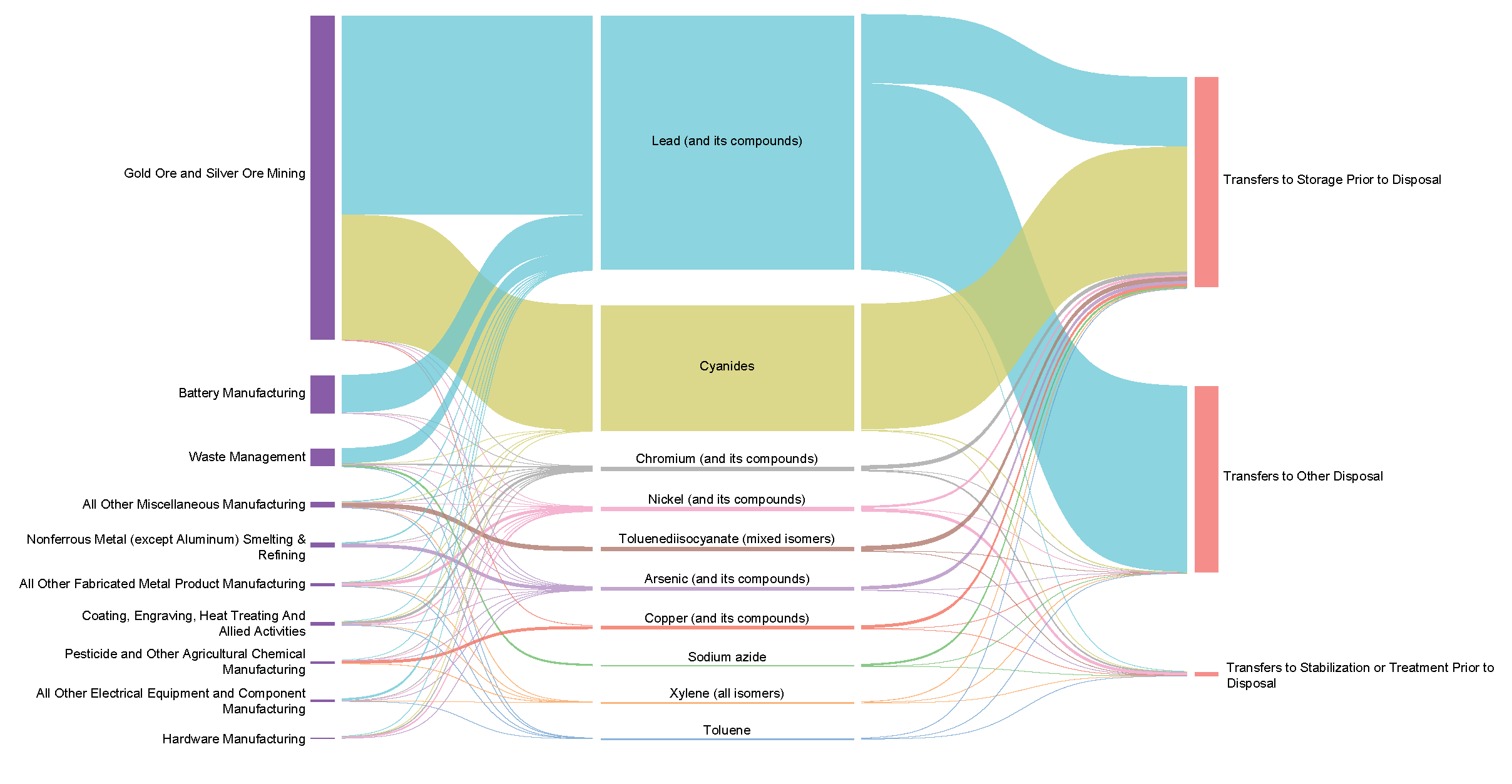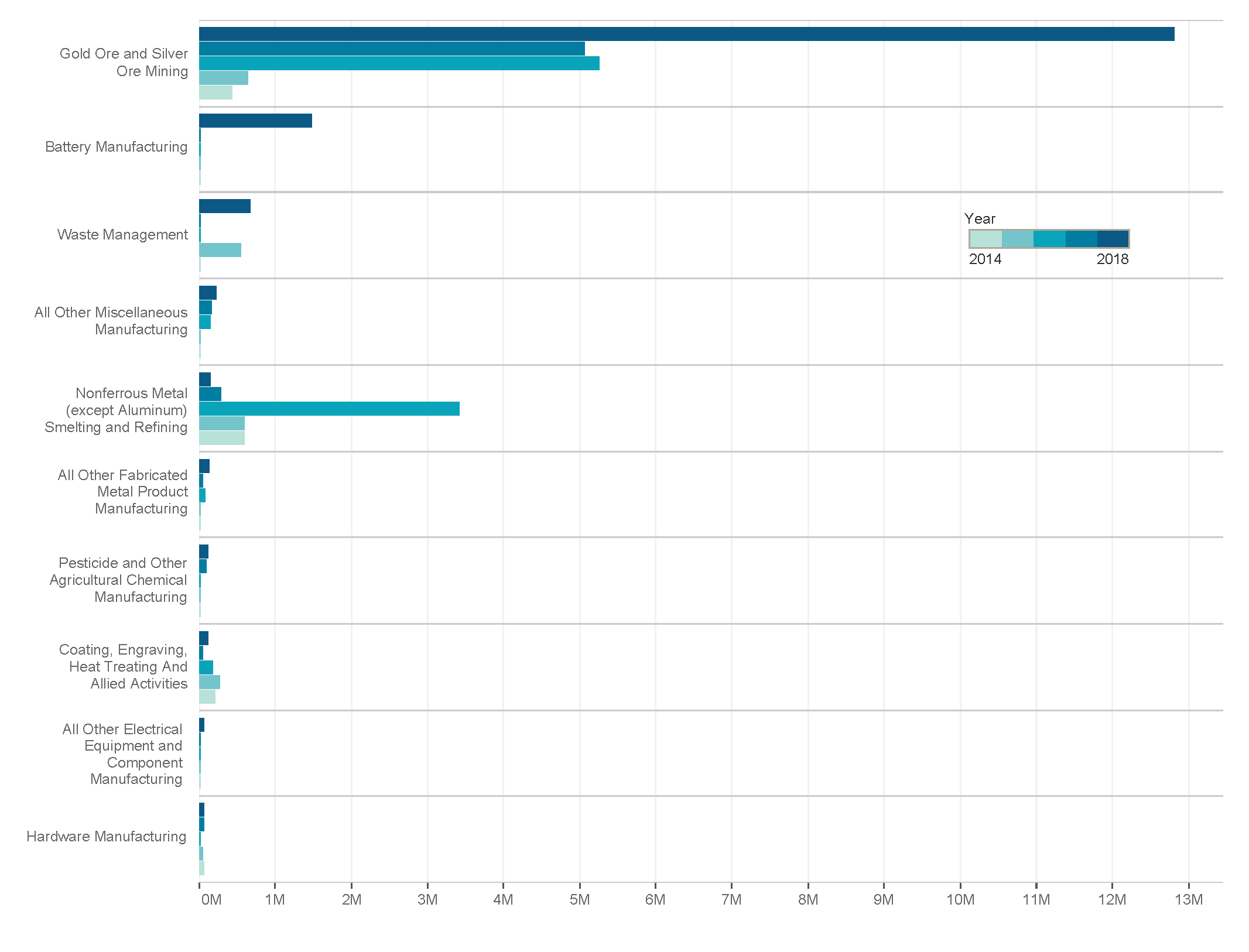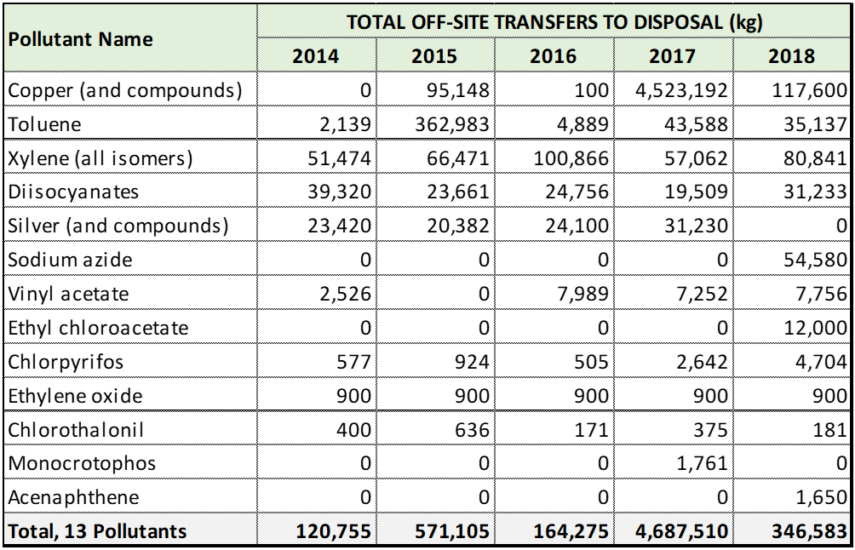2 Feature Analysis: Off-site Transfers to Disposal in North America, 2014–2018
2.4 Analysis of Off-site Transfers to Disposal, 2014–2018
2.4.4 Transfers to disposal in Mexico
Transfers to disposal reported by Mexican facilities for the 2014–2018 period ranged from just over 3.2 million kg in 2014 to almost 16.5 million kg in 2018 (Table 13) and represented approximately 160 industrial sectors and 35 pollutants.
Figure 18 shows the top industry sectors and pollutants for transfers to disposal in 2018. It also reveals that transfers to storage prior to disposal accounted for more than 50% of the total that year, followed by transfers to “other disposal (unknown).” Relatively small proportions were also transferred to treatment or stabilization prior to disposal. Readers are reminded that only three of the six off-site disposal practices discussed in this report are covered by Mexico’s PRTR.
Together, three sectors accounted for about 15 million kg, or 94%, of total transfers to disposal that year: the gold and silver mining, battery manufacturing, and waste management sectors. However, Figures 19a and 19b, which show how transfers to disposal in Mexico changed between 2014 and 2018, reveal data that are far from uniform.
Among the pollutants shown in Figure 19b are some that became subject to reporting in Mexico as of 2014, including copper compounds, toluene, xylenes, and sodium azide. As shown in Table 24, 13 of these new substances were transferred to disposal by Mexican facilities between 2014 and 2018.
Approximately 20 industry sectors and a total of 35 facilities reported transfers to disposal of these new pollutants, in amounts ranging from 120,000 to almost 600,000 kg each year.[59]
The three sectors shown in Table 25 reported in a fairly consistent manner between 2014 and 2018; together, they accounted for between 47 and 79% of annual transfers to disposal in Mexico. The large increase during this period was driven by the gold ore and silver ore mining sector (NAICS 21222).
Table 26 presents the top ten reporting facilities in the gold ore and silver ore mining sector. They transferred their waste (mainly lead, cyanide, nickel, copper, silver, and mercury compounds) to “other disposal (unknown),” or to storage prior to disposal.
Table 26. Transfers to Disposal Reported by Top Facilities in the Mexican Gold Ore and Silver Ore Mining Sector (NAICS 21222), 2014–2018
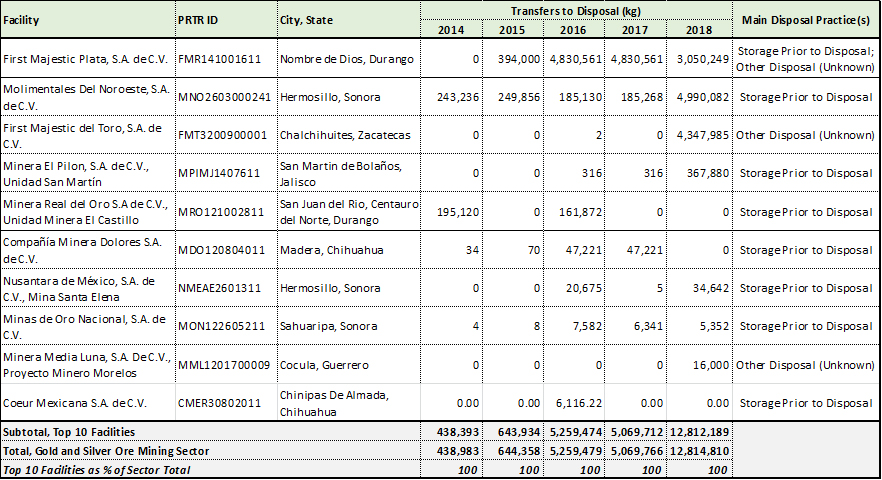
One facility, First Majestic Plata in the state of Durango, transferred large amounts of lead compounds to other disposal as of 2016. This Canadian-owned company has expanded its operations in Mexico in recent years. Its sister facility, First Majestic del Toro in Zacatecas, also transferred 4.3 million kg of lead compounds to other disposal in 2018. The Molimentales del Noroeste gold mine in Sonora reported transfers of 4.8 million kg of cyanide in 2018 to storage prior to disposal—a large increase from previous years. Readers will recall from section 2.3.1 that in Mexico, waste can be stored for a maximum of six months.
While off-site transfers to disposal accounted for almost 100% of the total reported by Mexican gold ore and silver ore mines, their Canadian and US counterparts disposed of approximately 99% of their waste—in the form of tailings (finely ground particles that can contain process chemicals such as cyanide), waste rock, and spent ore from heap leaching—in on-site landfills or surface impoundments. As explained in Taking Stock, Volume 15, under Mexico’s RETC disposals are considered off-site transfers, which largely explains the substantial difference between the total releases and transfers reported by gold and silver mines in Mexico and those in the other two countries[60] —i.e.:
- 45 Canadian mines reported about 352 million kg in total releases and transfers (of which 350 million kg disposed of in landfills or surface impoundments on site);
- 46 Mexican mines reported almost 13 million kg in total (with over 99% transferred to off-site disposal); and
- 44 US mines reported almost 163 million kg in total releases and transfers (with about 162 million kg disposed of in landfills or surface impoundments on site).
In Mexico, mining activities (from exploration through beneficiation) are regulated under the Mining Law by the Ministry of Economy’s Dirección General de Minas, with Semarnat involved in the application of certain environmental standards (called Normas Oficiales Mexicanas—NOM). This separation of authority contributes to the difficulty of understanding the nature and scale of mining waste deposited in on- and off-site locations. Since most hard-to-mitigate environmental impacts from mining activities are related to years of accumulated waste, having annual data on the types and amounts of substances contained in disposal areas is critical for managing risk in the event of accidents, as well as for communicating this information to potentially affected communities.[61]
Prior to 2016, the nonferrous metal processing sector (NAICS 3314) was the predominant sector in Mexico for transfers to disposal.[62] Of approximately 30 facilities in this sector that reported between 2014 and 2018, five together accounted for most of these transfers (Table 27). These facilities reported large amounts of lead and arsenic compounds, along with much smaller proportions of mercury, cadmium, chromium, and asbestos compounds, primarily as transfers to storage prior to disposal.
Table 27. Transfers to Disposal by the Top Facilities in the Mexican Nonferrous Metal Processing and Production Sector (NAICS 3314), 2014–2018
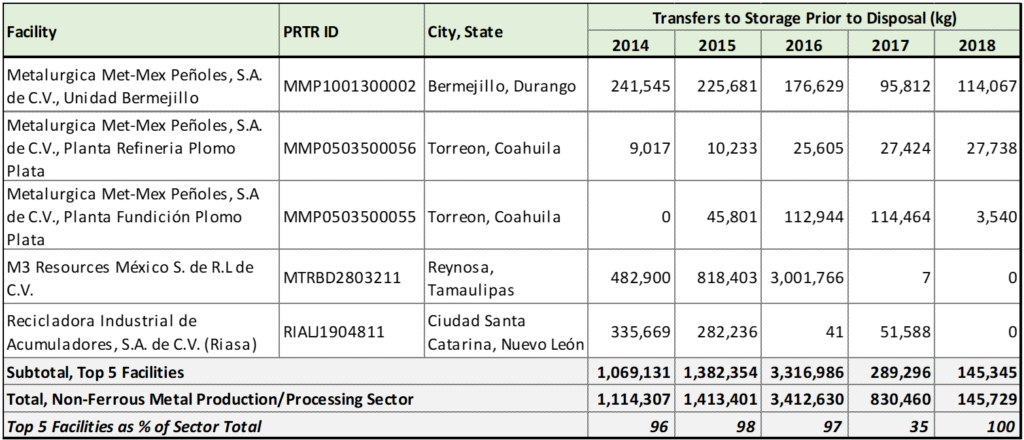
The coating, engraving, heat treating/allied activities sector (NAICS 33281) ranked third in Mexico for transfers to disposal, with amounts declining by about half —from 210,974 kg in 2014 to 104,299 kg in 2018. Close to 50 facilities reported during this period, but those reporting the largest quantities in 2018 were not the same as in 2014 (Table 28).
Table 28. Transfers to Disposal by Top Facilities in the Mexican Coating, Engraving, Heat Treating/Allied Activities Sector (NAICS 33281), 2014–2018
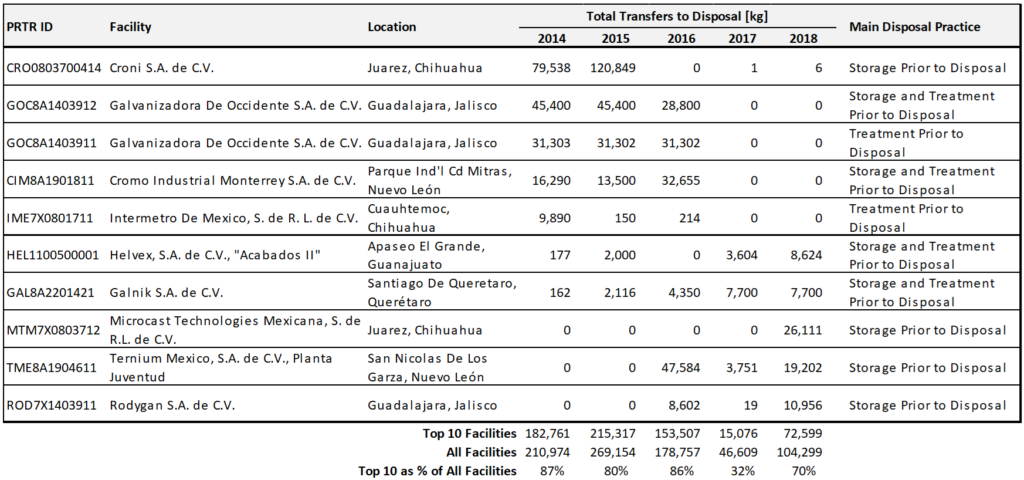
Several of these facilities operate within the maquiladora industry, providing services such as vehicle parts chrome plating, galvanizing, polishing, and painting, among others. They reported transfers of chromium and nickel compounds (which, together, accounted for more than 90% of the annual totals), as well as cyanide, styrene, and cadmium and lead compounds. Some of these pollutants were also transferred to recycling. Data for this sector in Canada and the United States show transfers to disposal of approximately 40 pollutants each year; however, the top pollutants reported in those countries—zinc compounds and nitric acid/nitrate compounds—are not subject to reporting in Mexico.[63]
Table 29 presents the transfers to storage prior to disposal reported by the top facilities in the waste management sector (NAICS 562). The five facilities that accounted for almost all of these transfers reported between two and eight pollutants each year, with the top substances being lead compounds, chromium compounds, and sodium azide. However, these data also reflect certain errors in the reporting of industry sector codes. For example, the Fundametz México website indicates that it is in the non-ferrous metal processing and production sector (NAICS 3314) and in fact, in 2017 this facility reported transfers of just over 540,000 kg to storage prior to disposal under that code. Similarly, while the Recicladora Industrial de Acumuladores (Riasa) facility’s website indicates that it is indeed a “remediation and other waste management services” company, between 2014 and 2017 this facility reported its transfers to storage prior to disposal under the code for non-ferrous metal processing and production (NAICS 3314) (Table 27).
Table 29. Transfers to Storage prior to Disposal by Top Facilities in the Mexican Waste Management Sector (NAICS 562), 2014–2018
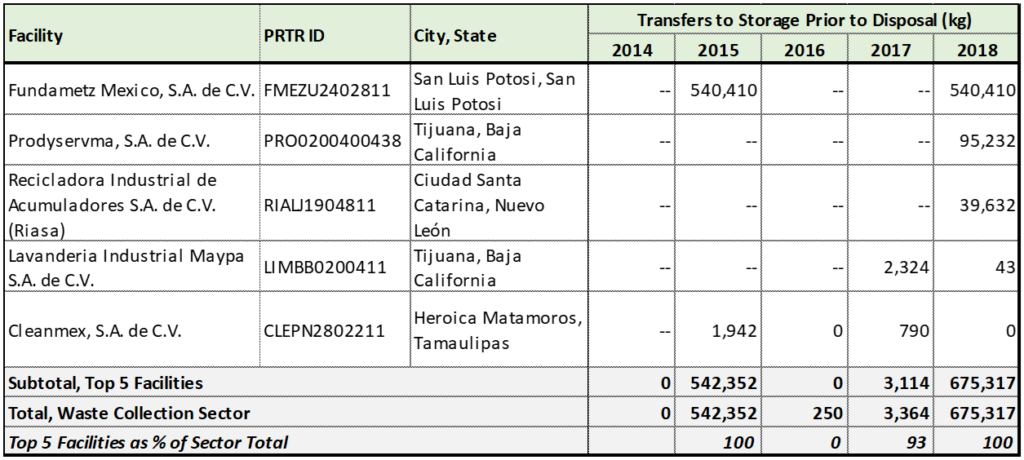
Errors in the NAICS codes reported by facilities (or in some cases, assigned to them by the PRTR program) and other data inconsistencies can have a significant impact on our ability to understand the releases and transfers generated by industrial activities in the region. These issues are being addressed through a collaborative effort, involving the CEC and the three national PRTR programs, to improve the quality and comparability of North American PRTR data.
[59] The exception was for 2017, when the Cuprosa – Planta Tlajomulco de Zuñiga, a fertilizer manufacturing facility located in Jalisco, reported transfers of more than 4.4 million kg of copper compounds to stabilization/treatment prior to disposal. Copper is used in fertilizer manufacturing and is an essential micronutrient that supports plant activities such as chlorophyll and seed production. See: University of Minnesota Extension. 2018. “Copper for crop production”.
[60] Another factor affecting the differences in the regional data for this sector is that manganese, vanadium, and zinc compounds (except for one zinc compound) are not subject to reporting in Mexico.
[61] See: Taking Stock, Volume 15
[62] Data for three related sectors (NAICS 33141, 33142, 33149) are combined in table 27 because some facilities reported under all three codes.
[63] Readers are reminded that only one zinc compound is subject to reporting in Mexico.
